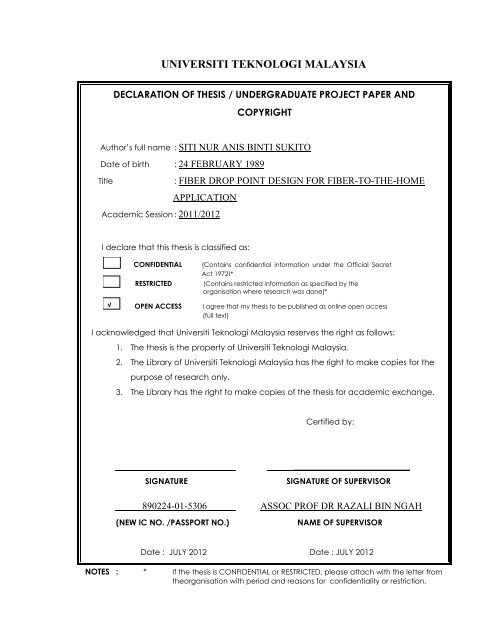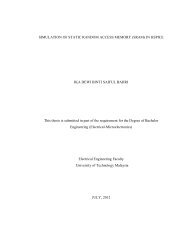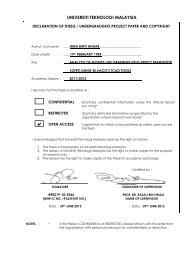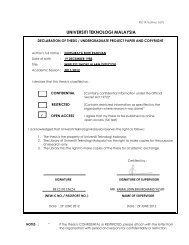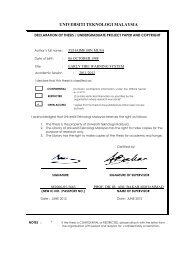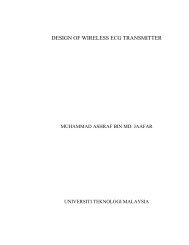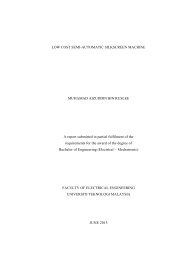universiti teknologi malaysia - Faculty of Electrical Engineering - UTM
universiti teknologi malaysia - Faculty of Electrical Engineering - UTM
universiti teknologi malaysia - Faculty of Electrical Engineering - UTM
Create successful ePaper yourself
Turn your PDF publications into a flip-book with our unique Google optimized e-Paper software.
UNIVERSITI TEKNOLOGI MALAYSIADECLARATION OF THESIS / UNDERGRADUATE PROJECT PAPER ANDCOPYRIGHTFIBER DROP POINT (FDP) DESIGN FOR FIBER-TO-THE-HOME (FTTH)Author’s full name : SITI NUR ANIS APPLICATIONBINTI SUKITODate <strong>of</strong> birth : 24 FEBRUARY 1989TitleAcademic Session : 2011/2012: FIBER DROP POINT DESIGN FOR FIBER-TO-THE-HOMEAPPLICATIONSITI NUR ANIS BINTI SUKITOI declare that this thesis is classified as:√CONFIDENTIALRESTRICTEDOPEN ACCESSA thesis submitted in Fulfillment <strong>of</strong> theRequirements for the Award <strong>of</strong> the degree <strong>of</strong> theDegree <strong>of</strong> Bachelor (full <strong>of</strong> text) <strong>Electrical</strong> Telecommunication <strong>Engineering</strong>I acknowledged that Universiti Teknologi Malaysia reserves the right as follows:1. The thesis is the property <strong>of</strong> Universiti Teknologi Malaysia.2. The Library <strong>of</strong> Universiti Teknologi Malaysia has the right to make copies for thepurpose <strong>of</strong> research only.(Contains confidential information under the Official SecretAct 1972)*(Contains restricted information as specified by theorganisation where research was done)*I agree that my thesis to be published as online open access<strong>Faculty</strong> <strong>of</strong> <strong>Electrical</strong> <strong>Engineering</strong>Universiti Teknologi Malaysia3. The Library has the right to make copies <strong>of</strong> the thesis for academic exchange.JULY 2012Certified by:_____________________________SIGNATURESIGNATURE OF SUPERVISOR890224-01-5306 ASSOC PROF DR RAZALI BIN NGAH(NEW IC NO. /PASSPORT NO.)NAME OF SUPERVISORDate : JULY 2012 Date : JULY 2012NOTES : * If the thesis is CONFIDENTIAL or RESTRICTED, please attach with the letter fromtheorganisation with period and reasons for confidentiality or restriction.
I hereby declare that I have read this thesis and in my opinion this thesis issufficient in term <strong>of</strong> scope and quality for the award <strong>of</strong> degree <strong>of</strong> Bachelor <strong>of</strong><strong>Electrical</strong> <strong>Engineering</strong> (Telecommunication)Signature: _______________________________Name <strong>of</strong> supervisor : ASSOC PROF DR RAZALI BIN NGAHDate : JULY 2012
FIBER DROP POINT DESIGN FOR FIBER-TO-THE-HOME APPLICATIONSITI NUR ANIS BINTI SUKITOA report submitted in partial fulfillment <strong>of</strong> therequirements for the award <strong>of</strong> the degree <strong>of</strong>Bachelor <strong>of</strong> <strong>Engineering</strong> (<strong>Electrical</strong> – Telecommunication)FACULTY OF ELECTRICAL ENGINEERINGUNIVERSITI TEKNOLOGI MALAYSIAJULY 2012
iiI declare that this thesis entitled “Fiber Drop Point (FDP) design for Fiber-To-The-Home (FTTH) application” is the result <strong>of</strong> my own research except as cited in thereferences. The thesis has not been accepted for any degree and is not concurrentlysubmitted in candidature <strong>of</strong> any other degree.Signature : ………………………………….Name : SITI NUR ANIS BINTI SUKITODate : JULY 2012
iiiSpecial dedicated to my beloved mother, father and siblings.To my supportive supervisor, for his guidance and encouragement..To my loyal friends, for their unconditionally support.
ivACKNKOWLEDGEMENTAlhamdulillah, praise to Allah for the guidance and strength given to me to completethis project. Please and blessing upon Prophet Muhammad S.A.W who has bring thelight to all mankind.I would like to deepest gratitude to my projects supervisor, Assoc Pr<strong>of</strong> Dr Razali BnNgah for his brilliant idea and guidance throughout completing this project. Hiswillingness to spend time guiding me is much appreciated.On the other side, I would like to thank to my parents who have been pillar <strong>of</strong> supportfor both mentally and financially. Without their support, this project may never beencompleted in time. Besides that, I would like to thank to all my friends in <strong>UTM</strong> forbeing there when the hardship come. All <strong>of</strong> their difficulties and ideas are sharedtogether and their supports make me keep going.Lastly, thanks to all my lecturers, technicians and postgraduate students who havetaught me throughout my four years study in <strong>UTM</strong>. The knowledge gain from them isone <strong>of</strong> the factors that contribute on completing this project.Thank you very much. May Allah bless all <strong>of</strong> you.
viABSTRAKObjektif projek ini adalah untuk mereka bentuk titik serat penurunan (FDP) bagigentian ke rumah (FTTH) permohonan dengan menggunakan Kemasukan Berganda danKeluaran Berganda Pemultipleksan Pembahagian Frekuensi Orthogonal (MIMO-OFDM) untuk meningkatkan kelajuan penghantaran. FDP akan menyediakanperkhidmatan jalur lebar berkelajuan tinggi ke rumah.Dalam projek ini, ia tertumpukepada merekabentuk FDP dan keupayaan isyarat yang dihantar telah diperiksa. FDPdisimulasi menggunakan perisian OptiSystem. Di dalam simulasi, analisis gambarajahburuj yang dijalankan yang mewakili prestasi penghantaran sistem FDP. Selain itu,projek ini juga memberi tumpuan kepada reka bentuk antena MIMO-OFDM denganmenggunakan Simulasi Komputer Perisian gelombang mikro. Akhir sekali, sistem iniberoperasi pada 802.11n rangkaian kawasan setempat tanpa wayar pada jalur 2.4GHzdengan kelajuan maksimum 130Mbps.
viiTABLE OF COTENTSCHAPTER TITLE PAGEDECLARATIONDEDICATIONACKNOWLEDGEMENTABSTRACTABSTRAKTABLE OF CONTENTSLIST OF TABLESLIST OF FIGURESLIST OF ABBREVIATIONSLIST OF SYMBOLSiiiiiivvviiviiixxixiiixv1 INTRODUCTION1.1 Project Background1.2 Objective1.3 Project Scope1.4 Thesis Outline13342 LITERATURE REVIEW2.1 Introduction2.2 Introduction <strong>of</strong> Fiber-To-The-Home2.3 The Concept <strong>of</strong> Fiber-To-The-Home2.4 The Advantage <strong>of</strong> FTTH2.5 Introduction <strong>of</strong> Radio over Fiber668910
viii2.6 The Concept <strong>of</strong> RoF2.7 The Advantage <strong>of</strong> RoF Technology2.8 Limitation <strong>of</strong> RoF Technology1012123 MULTIPLE INPUT MULTIPLR OUTPUT-ORTHOGONAL FREQUENCY DIVISIONMULTIPLEXING3.1 Introduction3.2 Multiple-Input-Multiple-Output (MIMO)3.3 The Advantage <strong>of</strong> MIMO3.4 Orthogonal Frequency-Division Multiplexing(OFDM)3.5 MIMO-OFDM3.6 IEEE 802.113.7 Dual Band and MIMO Microstrip Antenna3.8 Power amplifier3.9 Photodetector3.10 Remote Antenna Unit (RAU)131315151616182021234 RESEARCH METHODOLOGY4.1 Introduction4.2 Project Methodology4.3 Antenna design4.3.1 Antenna specification4.3.2 Optimization4.4 Fiber Drop Point Design4.5 FTTH System Design4.4.1 FDP Performance2627292933343540
ix5 RESULT AND ANALYSIS5.1 Introduction5.2 Simulation <strong>of</strong> Antenna5.2.1 Antenna gain5.2.2 Antenna Beamwidth5.2.3 Return loss, ,5.2.4 Conversion Method for AntennaRepresenting in 2 Port Network ScatteringParameter5.3 Simulation <strong>of</strong> FDP for FTTH System5.3.1 Transmitter Simulation Result5.3.2 Receiver Simulation Result5.3.2.1 Bit Rate <strong>of</strong> 130Mbps5.3.2.2 Bit Rate <strong>of</strong> 300Mbps5.3.2.3 Bit Rate <strong>of</strong> 600Mbps4141424345464747494951526 CONCLUSION6.1 Conclusion6.2 Recommendation5355REFERENCES 56
xLIST OF TABLESTABLE NO. TITLE PAGE3.13.24.14.25.15.2Comparison <strong>of</strong> different 802.11 transfer ratesDual band and MIMO Microstrip Antenna parameterAntenna SpecificationsGlobal parameter settingsS2P values for antenna in transmitting modeS2P values or antenna in receiving mode171930404647
xiLIST OF FIGURESFIGURE NO. TITLE PAGE1.22.12.22.33.13.23.33.43.53.64.14.24.34.44.54.65.15.25.35.45.55.6Proposed fiber drop point deploymentFTTH systemApplication <strong>of</strong> FDPRadio over Fiber systemExample <strong>of</strong> 2x2 MIMOOverview <strong>of</strong> the antenna designThe simulation result <strong>of</strong> final antennaBlock diagram <strong>of</strong> the single stage power amplifierPhotodetectorsExample <strong>of</strong> Remote Antenna Unit featuresFlow chart <strong>of</strong> the project methodologiesThe 2x2 MIMO Microstrip Patch Antenna dimensionFiber Drop PointThe overall system designConstellation Visuallizer at Subsystem 1M-Array Pulse Generator at Subsystem 3The antenna gain for Port 1The antenna gain for Port 2The antenna beamwidth for Port 1The antenna beamwidh for Port 2Return loss at ,Input at the Constellation Visuallizer 147811141819212324293435373939424344444548
xii5.75.85.95.10Input at the Constellation Visuallizer 2Output at the Output Constellation Visuallizer for130 MbpsOutput at the Output Constellation Visuallizer for300 MbpsOutput at the Output Constellation Visuallizer for 60Mbps48505152
xiiiLIST OF ABBREVIATIONBS - Base StationCS - Central StationCBS - Central Base StationCST - Computer Simulation TechnologyCO - Central OfficeCATV - Cable TelevisionDR - Dynamic RangeEVM - Error vector magnitudeFDP - Fiber Drop PointFTTH - Fiber-To-The-HomeGSM - Global System for MobileHSBB - High Speed BroadbandHPBW- Half Power BeamwidthIEEE - International <strong>of</strong> Electric <strong>Electrical</strong> <strong>Engineering</strong>ISM - Industrial, Scientific and MedicalLAN - Local Area NetworkLED - Light Emitting DiodeMIMO - Multiple Input Multiple OutputMAC - Medium Access LayerMCS - Mobile Switching CentreNGN - Next Generation NetworkNRZ - Non-Return-ZeroNF - Noise FigureOFDM- Orthogonal Frequency-Division Multiplexing
xivOTA - Over the AirOLST - Optical Lost Sets TestPD - Photo DetectorPRBS - Pseudo Random Bit SequenceQoS - Quality <strong>of</strong> ServicesQAM - Quadrature Amplitude ModulationRoF - Radio over FiberRAU - Remote Antenna UnitRF - Radio FrequencyRS - Remote SiteRIN - Relative Intensity NoiseSISO - Single Input Single OutputS2P - Two Port Network S-ParameterSCt - Central SiteSAP - Service Access PointTM - Telekom Malaysia BerhadTDMA- Time Division Multiple AccessWLAN- Wireless Local Area Network
xvLIST OF SYMBOLS- Antenna 0- Antenna 1E - Photoelectric effecth - Plank’s constantv - Frequency <strong>of</strong> radiation
CHAPTER 1INTRODUCTION1.1 Project BackgroundRecently, internet services have been used in the various fields either forbusiness, politic or education and many more. It makes the number <strong>of</strong> the internet userincrease. People need the reliable transmission medium to transmit high speed data andinformation, dependable voice service, and high speed quality video. The internetnetwork development had brought new technology to enhance the speed <strong>of</strong> thenetworking. One <strong>of</strong> the best solutions is by using the High Speed Broadband (HSBB).Telekom Malaysia Berhad (TM) is the only provider that provides this technology to theconsumer in Malaysia.Telekom Malaysia (TM) is the largest integrated communication provider inMalaysia, becoming one <strong>of</strong> the Asia’s leading communication companies. TM isfocusing more intently on its business <strong>of</strong> Internet and multimedia, data and the fixedline. In 2010, TM had launched Unify as the new Fiber-To-The-Home (FTTH)
2application system. It is a High Speed Broadband (HSBB) infrastructure deployment,Next Generation Network (NGN) migration and network quality and performanceimprovement. [1]FTTH is the ideal fiber-optic architecture. It was the high-speed networking,digital television and telephone service to residences using fiber optic cables. FTTH iscapable to support up to 100 Mbps to the user’s home. Ideally, this architecture <strong>of</strong> fiberdeployment is carried all the information data to the customers or premises.The FTTH last mile installation to the home users might face several challenges.One <strong>of</strong> the challenges is that the fiber cabling needs to be foreseen during the planningphase <strong>of</strong> the architecture and the landlords need to be convinced from day one. It isbecause the last mile installation process including to break the house <strong>of</strong> the users. Thecabling system needs to be protected during the building <strong>of</strong> the in-house infrastructure.Besides that, cabling system needs to become an easy to install solution enablinglower skilled labor to be used. The deployment <strong>of</strong> FTTH in Malaysia has become anissue due to the installation <strong>of</strong> fiber under or inside the house. User’s houses need to bedrilled in order to install fiber inside the home. In addition, the number <strong>of</strong> internetmobility increase rapidly.As the solution for the challenge occur, instead <strong>of</strong> using the fiber connected tothe home, the Wireless Local Area Network (WLAN) can be used to replace it as atransmission medium. The application can be provided by simulating the FDP for theFTTH system using Multiple Input Multiple Output- Orthogonal Frequency-DivisionMultiplexing (MIMO-OFDM) technique.
31.2 ObjectiveThe objective <strong>of</strong> this project is to design and simulate a fiber drop point (FDP)for the fiber-to-the-home (FTTH) system. The system will provide mobility access andease <strong>of</strong> installation. Apart from that, it will analyze the performance <strong>of</strong> the FDP fortransmission signal using OptiSystem s<strong>of</strong>tware. The FDP will operate frequency <strong>of</strong>2.4GHz.1.3 Project ScopeThe scope <strong>of</strong> this project is focuses on the designing the FDP for FTTHapplication. The concept <strong>of</strong> FTTH system and MIMO-OFDM will be study. Theantenna scattering parameter is analyzed by simulating the 2x2 MIMO antenna usingCST Microwave Office s<strong>of</strong>tware. Next, the overall FDP system is simulated usingOptiSystem s<strong>of</strong>tware. The simulation and performance analysis on the system will beinvestigated. The whole system operates at 2.4GHz band.1.4 Thesis OutlineIn this thesis, it is organized into six chapters to cover the whole projectactivities. It consists <strong>of</strong> introduction, literature review 1, literature review 2,
4methodology, expected results, and conclusion. In addition, some <strong>of</strong> the informationthat related to this project is attached.CAPTER 1 describes the general idea <strong>of</strong> the whole report.information on the introduction, objective <strong>of</strong> the project, and project scope.It is consists theCHAPTER 2 presents the literature review. It reviews on the information <strong>of</strong> theoverall FTTH system, the concept <strong>of</strong> FTTH, the advantage <strong>of</strong> FTTH, the overall RoFsystem, the concept <strong>of</strong> RoF, the advantage <strong>of</strong> RoF and the limitation <strong>of</strong> RoF.CHAPTER 3 reviews on the Multiple-Input-Multiple-Output (MIMO) antenna,the Orthogonal Frequency-Division Multiplexing (OFDM) , MIMO-OFDM, IEEE802.11, power amplifier, photodetector and Remote Antenna Unit (RAU) will bediscussed in this chapterCHAPTER 4 describes the project methodological process that will be used inthis project. There are seven step in this project and will be explained briefly in thischapter.CHAPTER 5 present the result and discussion obtained from the simulationmodel. Finally, the conclusion <strong>of</strong> the study will be concluded in CHAPTER 6.
CHAPTER 2LITERATURE REVIEW2.1 IntroductionIn this chapter, there is some information on Fiber-To-The-Home (FTTH)system like introduction <strong>of</strong> FTTH, the concept <strong>of</strong> FTTH, the benefits <strong>of</strong> FTTH. Besidesthat, there are also information on the overall Radio over Fiber (RoF) system, theconcept, advantage and the limitation <strong>of</strong> RoF.2.2 Introduction <strong>of</strong> Fiber-To-The-HomeFTTH has been recognized to be the new solution for providing broadband tothe community FTTH <strong>of</strong>fers more bandwidth and more flexibility. The purpose <strong>of</strong>optical fiber is to perform high speed, error-free data transmission. It is an optimal,
6practical and affordable broadband telecommunication service using the fiber opticcables. Figure 2.1 shows the overall <strong>of</strong> FTTH system. From the network access point,the optical fiber distribute to the ordinary single residence up to the inside household.This network provide 50~100Mbps as well as guarantee quality <strong>of</strong> services (QoS).Figure 2.1: FTTH system [14]Fiber optic is cost effective in long distance network. Compared to the copperwire, optical fiber could carry thousands <strong>of</strong> conversation via telephony hundreds <strong>of</strong> timefurther, making cut in cost on the phone connection over fiber. It is reliable to supplythe voice, data, screen, broadcasting and etc.The wired transmission medium had limited connection only up to 5km from theexchange. Unlike Digital Subscriber Line (DSL), FTTH <strong>of</strong>fers higher speed and betterthroughput quality compared to the wired. The FTTH connection is enabling to coverfrom 10km to 20km in distance service.The basic design <strong>of</strong> FTTH system is shown in Figure 2.2. In central basestation, the baseband signal is modulate by 802.11n OFDM modulator. The signal is
7then send to the FDP via optical fiber. Photodetector detected the input signal and passthrough the power amplifier and deliver it to the users by using WLAN application.Figure 2.2: Application <strong>of</strong> FDP2.3 The Concept <strong>of</strong> Fiber-To-The-HomeIn FTTH system, the equipment at the central <strong>of</strong>fice (CO) is connected to theATM or internet interfaces. The video services will enter the system from the cabletelevision (CATV) head end or from the satellite feed. All <strong>of</strong> the signal will bemodulate by OFDM modulator and transmitted through a single wire to the opticalsplitter. The splitter is normally placed approximately 30,000 feet from the central<strong>of</strong>fice.
8The FTTH network interface can provide service bandwidth <strong>of</strong> 100Mbps up to1Gbps to each subscriber. The network bandwidth can support various home networkservices for each one. During the construction <strong>of</strong> FTTH network, the outside-plant partlevel is tested using the Optical Lost Sets Test (OLSTs). The fiber need to be tested asthey are the last fiber links before the customer.2.4 The Advantage <strong>of</strong> FTTHGenerally, FTTH <strong>of</strong>fer a lot <strong>of</strong> advantage through its system. It is a passivenetwork, thus minimize the network maintenance cost and requirements. FTTH providesingle fiber to the end user. This network system is reliable, scalable and secure to theconsumers. In addition, FTTH network is a future-pro<strong>of</strong> architecture. [2]Another advantage <strong>of</strong> FTTH system is that, it was the technologies that enable todeliver enough bandwidth, reliably at the low cost rate, to meet the consumers’ demandsover the next decades. In addition, the installation cost <strong>of</strong> FTTH system is reasonablemake it affordable for the number <strong>of</strong> company racing to install it. Besides that, FTTH isdelivering high-margin services to the consumers and they are willing to pay for it eitherthan using the traditional cable TV services.In the future, FTTH will be the only technology that can meet the consumersneed when the 3-D, holographic high-definition TV and games will be in everyday use.It is the product that already produces in the industry, and beginning to becommercialized for consumers. [3]
92.5 Introduction <strong>of</strong> Radio over FiberNowadays, the Radio over Fiber (ROF) technology can integrate bothadvantages <strong>of</strong> fiber optic networks and wireless. It is use in numerous applications inbroadband wireless communications (e.g. WLAN, GSM, and UMTS) . In contrast toother transmission media, optical fiber has superior properties, such as light weight, lowattenuation loss, small size, and especially the large bandwidth and insensitivity toelectromagnetic radiation. These advantages make it the optimal solution for efficientlytransporting radio signals in wireless network.The upcoming wireless network will use the combination <strong>of</strong> air-interfacemethods in different channels and in different cells that can be changed dynamically tomeet variations in traffic conditions. The access methods such as adaptive TDMA, TD-CDMA and WDCMA in the network could employ s<strong>of</strong>tware-radio approaches in theimplementation <strong>of</strong> the base station.2.6 The Concept <strong>of</strong> RoFRadio over Fiber (Ro F) is a technology where the electrical signals aredistributed by the optical components. RoF system consists <strong>of</strong> a Central Site (CSt) andthe Remote Site (RS) which are connected with fiber optic network. For the GlobalSystem for Mobile (GSM) network, CS is similar to the Mobile Switching Centre(MCS) and RS is similar to the Base Station (BS). RF signal processing functions suchas frequency up-conversion, carrier modulation, and multiplexing, are performed at theBS or the Remote Antenna Unit (RAU), and immediately fed into the antenna as shown
10in Figure 2.3.RAUs are simplified significantly, as they only need to performoptoelectronic conversion and amplification functions.Figure 2.3: Radio over Fiber system [21]RoF technology requires the application <strong>of</strong> optical fiber connections to distributethe RF signals from a central location to RAU which <strong>of</strong>fers low signal loss (0.3 dB/kmfor 1550 nm, and 0.5 dB/km for 1310 nm wavelengths) to distribute the RF signals tothe RAUs. In a narrow communication systems and WLAN, the processing RF signalsfunction such as modulation carrier. RoF makes the processing signal function into thecentralized location to share with and RAU is distribute the RF signal with the use <strong>of</strong>optical fiber.
112.7 The advantage <strong>of</strong> ROF TechnologyThere are seven advantages <strong>of</strong> the RoF Technology are highlighted through thispart, such as:i. Low attenuation loss at the optical fiberii. Large bandwidthiii. Immunity to radio frequency interferenceiv. Easy installation and maintenancev. Reduce power consumptionvi. Multi-Operator and multi service operationvii. Dynamic resource allocation2.8 Limitation <strong>of</strong> RoF TechnologyRoF is an analogue transmission system since it involves analogue modulation,and detection <strong>of</strong> light. Therefore, signal impairments such as noise and distortion,which are important in analogue communication systems, are important in RoF systemsas well. These impairments tend to limit the Noise Figure (NF) and Dynamic Range(DR) <strong>of</strong> the RoF links [17]. DR is a very important parameter for mobile (cellular)communication systems such as GSM because the power received at the BS varieswidely. The noise sources in analogue optical fiber links include the laser’s RelativeIntensity Noise (RIN), the laser’s phase noise, the photodiode’s shot noise, theamplifier’s thermal noise, and the fiber’s dispersion.
CHAPTER 3MULTIPLE INPUT MULTIPLR OUTPUT-ORTHOGONAL FREQUENCYDIVISION MULTIPLEXING3.1 IntroductionThis chapter reviews the information on the Multiple-Input-Multiple-Output(MIMO), the benefit <strong>of</strong> MIMO antenna and an example <strong>of</strong> Patch antenna will bestudied. This chapter also discussed on OFDM and the advantages <strong>of</strong> MIMO-OFDMantenna. Besides that, it also reviews on the IEEE 802.11, power amplifier,photodetector and RAU.
133.2 Multiple-Input-Multiple-Output (MIMO)Multiple-Input-Multiple-Output (MIMO) is where the signals are transmitted viamultiple input <strong>of</strong> antenna and received by multiple output <strong>of</strong> antenna. The number <strong>of</strong>antenna elements at both transmitter and receiver are normally greater than two. Thistechnique has the advantage <strong>of</strong> increasing the data transmission in wirelessenvironment. [4]The system is operates by exploiting the spatial properties <strong>of</strong> the multipathchannel. Hence, it <strong>of</strong>fers a new dimension that can be used to enhance thecommunication performance. Other than signal processing as the element <strong>of</strong> successfulimplementation <strong>of</strong> MIMO antenna, the propagation channel and antenna design isrepresent the major parameters that ultimately impact the system performance. [5] TheFigure 3.1 represents the example <strong>of</strong> 2x2 MIMO antennas. It shows two transmitterantennas with two receiver antenna.Figure 3.1: Example <strong>of</strong> 2x2 MIMO [4]
143.3 The Advantage <strong>of</strong> MIMOThere are several benefits <strong>of</strong> using the MIMO antenna compared to the Single-Input-Single-Output (SISO) antenna. The benefit includes:1. Improved signal to noise ratio through increased antenna array gain2. Improved link reliability using phase nulling techniques3. Improved the ability to ignore other signals which inhabit the same band4. The capacity <strong>of</strong> a wireless link increases linearly with minimum <strong>of</strong> thenumber <strong>of</strong> transmitter or receiver antennas3.4 Orthogonal Frequency-Division Multiplexing (OFDM)OFDM is a combination <strong>of</strong> both modulation and multiplexing. Compared to thegeneral multiplexing technique, this technique is applied only to one independentchannel. The OFDM are used in 802.11a and 802.11g data transmissions <strong>of</strong>fers greaterperformance than the previous direct-sequence systems. It is capable <strong>of</strong> coping with thehighly-frequency selective, time-variant channel characteristics associated with mobilewireless communication channels. This technique is used for enhancing the data rate.The OFDM technique work by a single data stream that divided or spitted intoseveral paralleled stream and each <strong>of</strong> the data stream (or sub -set) is modulated byseparate carrier. Therefore, it does not require the frequency guard band needed fordirect sequence. These guard bands cause the bandwidth efficiency lowered and wasteup to 50% <strong>of</strong> the available bandwidth. The sub-set is then multiplexed into the OFDMsignal for transmission. Each <strong>of</strong> the independent sub-set channel can either multiplexed
15by frequency or code division multiplexing.Multiplexing is a method where thebandwidth is shared with some other independent communication data channels.3.5 MIMO-OFDMMIMO-OFDM is known as a key building block for the next generation wirelesscommunication system supported with the IEEE 802.11n band standards. Thecombination <strong>of</strong> MIMO signal with the OFDM will enhance the performance <strong>of</strong> WLANsystem. It is improving the capacity, coverage and reliability <strong>of</strong> the transmissiondata.[4]After a signal generated is by the OFDM technique, it is then transmittedthrough a number <strong>of</strong> antennas in order to achieve higher transmission rate. Thus, it iscalled as MIMO-OFDM. The spacing <strong>of</strong> MIMO antenna must be appropriately donedepending on the type <strong>of</strong> channel to make it the efficient antenna. The spacing at leasthalf <strong>of</strong> the wavelengths <strong>of</strong> the transmitting signal.3.6 IEEE 802.11In 1990, the IEEE 802 Committee formed a new working group which is IEEE802.11. It is specifically devoted to wireless LANs, with a charter to develop a MACprotocol and physical medium specification. Initially, the main interest was to develop
16a new wireless LAN operating in industrial, scientific and medical (ISM) band.However, the demanded for WLANs at different frequencies and data rates hasexploded.The IEEE 802.11 working group has expanded the standard from time to time.Table 3.1 shows the comparison <strong>of</strong> different 802.11 transfer rates <strong>of</strong> Wireless LANthroughput by IEEE standards. IEEE 802.11a/b/g/n is primary a local area networkingtechnology design to provide in-building or campus broadband coverage.Table 3.1: Comparison <strong>of</strong> different 802.11 transfer rates [20]IEEEWLANStandardOver-the-Air (OTA)EstimatesMedia Access Control Layer,Service Access Point (MACSAP) Estimates802.11b 11Mbps 5Mbps802.11g 54Mbps 25Mbps(when .11b is not present)802.11a 54Mbps 25Mbps802.11n 200+Mbps 100Mbps802.11n’s advertised throughput, security, and reliability will allow Wi-Fi toreplace existing wired networks. This 802.11 modulation technique is the standard touse in several modulation techniques to encode the transmitted data onto the radi<strong>of</strong>requency (RF) signal. These modulation techniques are used to enhance theprobability <strong>of</strong> the receiver correctly receiving the data and thus reducing the need forretransmissions. The techniques vary in their complexities and robustness to RF signalpropagation impairments. [7]
173.7 Dual Band and MIMO Microstrip AntennaDual band MIMO Microstrip antenna was design as the new antenna for IEEE802.11b and 802.11n WLANs standards. It is focused on the studying, designing andmanufacturing a dual band and MIMO antenna. This type <strong>of</strong> antenna can work at2.4GHz and 5 GHz frequencies. The proposed antenna had experimentally studied tomeasure its performance on both frequencies. The overview on the antenna design isshown in Figure 3.2. The antenna dimension was calculated with the specific designparameter.Figure 3.2: Overview <strong>of</strong> the antenna design [1]The antenna is printed on FR4 substrate with the W x L = 40mm x 65mm insize. The thickness <strong>of</strong> the substrate is 1.6mm and relative permittivity <strong>of</strong> 4.4. Thestudied is focused to have a good second resonant frequency since it have more than oneresonant frequency at the same antenna. The designing process was using the CSTMicrowave Studio s<strong>of</strong>tware. Table 3.2shows the characteristic <strong>of</strong> the antenna design.
18Table 3.2: Dual band and MIMO Microstrip Antenna parameterAntenna type Dual band and MIMO MicrostripAntennaOperating frequency 2.4 GHz and 5GHz (BW= 0.085-0.12GHz)Thickness1.6mmW65mmL39mmR110mmR28mmSubstrateFR4Return loss
193.8 Power AmplifierAn amplifier is a device that usually increases the amplitude <strong>of</strong> a signal. Therelationship between the inputs to the output <strong>of</strong> an amplifier is expressed as a function<strong>of</strong> the input frequency. This function is called as a transfer function <strong>of</strong> the amplifier andthe magnitude is determined as gain.The amplifier gain is the ratio <strong>of</strong> the output to the input power or amplitude andmeasured is decibels. The bandwidth <strong>of</strong> an amplifier is the range <strong>of</strong> the frequencieswhere the amplifier will give the satisfactory performance. In other hand, thebandwidth can be defined as the difference between the lower and upper half powerpoints. It is also known as the -3dB bandwidth.Power amplifier is usually place at the last stage <strong>of</strong> the transmitter end andboosts the signal power high enough so that it can propagate the signal at the requireddistance over the wireless medium. Typically, the power is delivered to an antennawhich acts like a 50Ω load.High efficiency power amplifier is desired for mobile communication network.Efficiency is measured <strong>of</strong> how much <strong>of</strong> the input power is applied to the amplifiersoutput. An increase in power amplifier’s efficiencies causes lower power consumption,less cooling requirements and lower cost <strong>of</strong> the system. This efficiency is depends onthe amplifier classes on RF Power Amplifiers, such as cellular base stations andbroadcast transmitters, specialist design technique are used to improve efficiency.
20To design a power amplifier, several designs characteristic must be considered.Figure 3.4 shows the block diagram <strong>of</strong> the single stage power amplifier. This blockdiagram is the typical design <strong>of</strong> an amplifier circuit. The central block is represents atransistor which is characterized by its S-parameters. The left and right <strong>of</strong> thetransistors represent the input matching network and the output matching network <strong>of</strong> theamplifier. Both are necessary to provide good impedance matching between theamplifier circuits. [8]DCSOURCEINPUTPORTINP<strong>UTM</strong>ATCHINGOUP<strong>UTM</strong>ATCHINGOUTPUTPORTFigure 3.4: Block diagram <strong>of</strong> the single stage power amplifier3.9 PhotodetectorOn 1990, Mark Planck had discovered that the energy is radiate in small discreteunits known as quanta. He is also discovered the universal constant <strong>of</strong> nature calledPlank’s constant. Both discoveries form a new physics term known as quantummechanics and the photoelectric effect = h where the Planks constant multiplied by
21frequency <strong>of</strong> radiation. The photo electric effect is the effect <strong>of</strong> the light on a surface <strong>of</strong>metal in a vacuum, the result is electrons being injected from the surface this explainsthe principle theory <strong>of</strong> light energy that allows photo detectors to operate. [14]Photo detector used as optical receiver to convert light into electrical energy. Itapplies the photoelectric effect, which the effect <strong>of</strong> light on a circuit. The junction usesan illumination window with an anti-reflect coating to absorb the light photons. Theabsorption <strong>of</strong> photons is the creation <strong>of</strong> electron-hole pairs in the depletion region.Examples <strong>of</strong> photo detectors are photodiodes and phototransistors. Other opticaldevices that similar to the photo detectors are solar cells which also absorb light andturn it into energy. A similar but different optical device is the Light Emitting Diode(LED) which is basically the inverse <strong>of</strong> photodiode, it converting light to a voltage orcurrent and vice versa.The Figure 3.5 shows the interface <strong>of</strong> photo detectors. Photodetector arecommonly used as safety devices in homes in the form <strong>of</strong> a smoke detector, also inconjunction with other optical devices to form security systems and many more. Thecircuit that uses photo diode use either normally closed or normally open contactsdepending on the desired operation. Besides that, photo diodes are also used with lasersto form security system. When the light projected by the laser to the photo diodes isbroken the security alarm is tripped.
22Figure 3.5: PhotodetectorsOne <strong>of</strong> the applications <strong>of</strong> photo detectors is street lights. The photo diode isattached to the switch-on relays to turn on the street light and when the diode fails toconduct, it turns <strong>of</strong>f <strong>of</strong> the street light. For the smoke detection application, the photodiode is attached to the relay switch and connected to the fire alarm. When the photodiode conducts, it keeps the normally closed switch to open preventing the alarm fromactivating. When the photo diode fails to conduct, the switch is closed and activates thefire alarm. [9]3.10 Remote Antenna Unit (RAU)Radios over fiber (Ro F) system are widely used for radio links in accessnetwork. They have many advantages over the conventional radio frequency systemssuch as lower attenuation with distance, interference immunity, wide bandwidthavailable, lower power consumption, enhanced microcellular coverage and easierinstallation. The optical signal can be obtained directly from a radio frequencygenerator/oscillator located at the CS or can be obtained from the beating <strong>of</strong> two optical
23signals at the photodetector located at the RAU.heterodyne radio frequency generation. [11]These techniques are called asFigure 3.6 shows the example <strong>of</strong> RAU features that usually used by consumers.RAU contain an optical simulator that had a plurality <strong>of</strong> ports. Besides that, it also hasan electric field absorption modulator for first input/output end and a second reflectiveend, another electric field absorption modulator configured used to modulate atransmitted optical signal to the data signal and modulate the demodulated signalaccording to the electrical signal. A filter is filled in between the optical circulator andthe electric field absorption modulator. The filter is configured to transmit an opticalsignal from input port <strong>of</strong> the optical circulator toward the electric field absorptionmodulator. It is then reflect the remaining optical signals into the port <strong>of</strong> opticalcirculator. [1]Figure 3.6: Example <strong>of</strong> Remote Antenna Unit featuresRAU provide high-quality, seamless coverage <strong>of</strong> radio signal that connected to aremote central station (CS) using the RoF technique. RAU are design to be very simple,small, easy to install, almost maintenance free and low cost. It is a very small antenna
24unit picks up radio signals from the operator’s hand-held remote control. Then itdecodes the signal and sends the information to the larger Receiver Unit via a cable oroptical fiber. At the bottom <strong>of</strong> the antenna unit is placed a powerful magnet allow it tobe easily attached (upside down) at the CS. In this position, RAU will receive excellentradio signals from the operator’s control unit. The connection cable should be longenough to put the Receiver Unit anywhere. [12]
CHAPTER 4RESEARCH METHODOLOGY4.1 IntroductionThis chapter is highlighted the design process for 2x2 MIMO Microstrip PatchAntenna and the design <strong>of</strong> the FDP for the FTTH application. It included the systemsimulation by using the CST Microwave Studio S<strong>of</strong>tware for the antenna design andOptiSystem S<strong>of</strong>tware for the FDP design. The antenna design then will be simulatedand incorporated in the OptiSystem s<strong>of</strong>tware to measure the FDP performance for theFTTH system at the receiver end.
264.2 Project MethodologyFigure 4.1 shows the overall project methodology process <strong>of</strong> designing the FDPfor FTTH application. Firstly, the concept <strong>of</strong> the Fiber-To-The-Home (FTTH) systemhas been studied and fully understood. FTTH system is well known as one <strong>of</strong> the HighSpeed Broadband (HSBB) service that available in this country.Through step 2, the brief idea on power amplifier and MIMO-OFDM antennahas been studied. This is because the combination <strong>of</strong> MIMO-OFDM antenna willimprove capacity, coverage and reliability <strong>of</strong> the antenna performance.Step 3 carries out the technique on using the relevant equipment simulationstools which is OptiSystem and CST Microwave Office s<strong>of</strong>tware. The flows on usingthe s<strong>of</strong>tware have been studied and practice the s<strong>of</strong>tware by doing some tutorialquestion.The process continued with designing the 2x2 spatial stream <strong>of</strong> MIMOMicrostrip Patch antennas and simulated by using the CST Microwave Studio s<strong>of</strong>tware.The antenna design will be based on the parameter has been stated. Hence, the Sparameter <strong>of</strong> the antenna design then will be converted into the S2P file to be used inthe OptiSystem simulation s<strong>of</strong>tware.Next step 5, FDP has been design for providing the wireless hotspot to the enduser in the FTTH system. The component used for the design was photodetector,amplifier and antenna
27Step 7 • Result analysis and report writingIn step 6, the overall system <strong>of</strong> FDP has been design and simulated using theOptiSystem s<strong>of</strong>tware. This s<strong>of</strong>tware is enables to plan, test, and simulate almost everytype <strong>of</strong> optical link system due to the rapidly involving, innovative and its powerfuldesign tools. The performance <strong>of</strong> the FDP at the end user will be determined by usingthe constellation diagram.Lastly, there will be result analysis and report writing based on the FDPperformance in the constellation diagram in the OptiSystem s<strong>of</strong>tware.Step 1• Study and fully understand the Fiber-To-The-Home (FTTH) system• Literature review on power amplifier and MIMO antenna forStep 2IEEE802.11n• Study and understand the relevant equipment communicationStep 3simulation tools which is OptiSystem ans CST Microwave Offices<strong>of</strong>twareStep 4• Design the 2x2 spatial stream <strong>of</strong> MIMO Miocrostrip Patch AntennaStep 5• Design FDP with various bit rateStep 6• Simulate the whole system using OptiSystem s<strong>of</strong>twareFigure 4.1: Flow chart <strong>of</strong> the project methodologies
284.3 Antenna DesignMIMO antenna design will provide narrowband at the frequency 2.4GHz for802.11n band. A MIMMO Microstrip Patch antenna is narrowband, wide beam antennafabricated by etching the antenna element pattern in trace bonded to an insulatingdielectric substrate with a continuous metal layer bonded to the opposite side <strong>of</strong> thesubstrate which forms a ground plane. Common microstrip antenna radiator shapes aresquare, rectangular, circular and elliptical, but any continuous shape is possible. Themost commonly employed microstrip antenna is a rectangular patch.4.3.1 Antenna SpecificationThe process <strong>of</strong> designing 2x2 MIMO Microstrip Patch Antenna starts withchoosing the antenna specification. The specification is based on the criteria that willprovide full coverage to the end users. The desired parameter will be calculated byusing 2.4GHz for the center frequency ( ) and 3 × 10 for the velocity <strong>of</strong> light(c). Table 4.1 below had listed the antenna specification for the design process.
29Table 4.1: Antenna SpecificationsAntenna SpecificationsValuesAntenna types2x2 MIMO Microstrip Patch antennaOperating frequency2.4-2.48GhzGain5-6dBiReturn loss, , < - 10dBFR4 dielectric constant 4.7FR4 thickness1.6mmMatching Impedance 50ΩPatch width,=2=0.2998 × 102(2.4 × 10 ).= 0.03699712366= 36.99712366≈ 37Effective dielectric constant,= + 12+− 1( )= 4.7 + 12+= 4.351062119(4.7 − 1. ×. ×)
30Effective length,= 20.2998 × 10=2(2.4 × 10 )√4.351062119= 0.02994282343= 29.94282343Patch length,∆ = 0.412 × h ×+ 0.3 + 0.246− 0.3 + 0.8(4.351062119 + 0.3)= 0.412 × 1.6 × 10 ×(4.351062119 − 0.3)= 0.412 × 1.6 × 10 × 108.775330697.91915305. ×. ×. ×. ×+ 0.246+ 0.8= 7.322847032 × 10= − 2∆= 0.02847825402= 28.47825402≈ 28.48Focal point,=11 + 121=1 + 12= 0.772852308. ×. ×
31= + 12= 4.7 + 12= 4.27977677+ − 1 ( )2+ 4.7 − 1 (0.772852308)2Position from x-axis,= ×28.47825402 × 10=2 × √4.27977677= 6.882921324 × 10Position from y-axis,==36.99712366 × 102= 0.01849856183= 18.49856183Wavelength propagation in substrate,=0.2998 × 10=√4.351062119= 110167218== 1101672182.4 × 10= 0.0459030075= 45.9030075 × 10
32≈ 45.90 × 10Addition for grounding size at each side,4=45.9030075 × 104= 11.47575187 × 10≈ 11.4764.3.2 OptimizationThe calculation with detail specification for 2x2 MIMO Microstrip Patchantennas has come out with the physical dimension <strong>of</strong> the design. This design was latersimulated at the CST Microwave Office S<strong>of</strong>tware and the antenna performance ismeasured for the return loss, gain, bandwidth and beamwidth.Figure 4.2 shows the dimensions <strong>of</strong> the antenna after the calculation <strong>of</strong>parameters based on design specifications. After simulation process in CST MicrowaveOffice s<strong>of</strong>tware, the results obtained for the antenna return loss are not as the desiredspecification. Thus, some adjustments in the dimensions <strong>of</strong> the antenna have been madeto obtain the desired specifications <strong>of</strong> the directivity which is less than -10dB.
3337.00mm28.48mm1.5mm11.215mm3.05mm20.5mm7.5mmFigure 4.2: The 2x2 MIMO Microstrip Patch Antenna dimension4.4 Fiber Drop Point DesignFDP is made up <strong>of</strong> three components that will provide wireless hotspot to endusers which are photodetector, amplifier and antenna. Figure 4.3 below shows theproposed FDP design for the FTTH application. Photodetector will act as the optical toelectrical converter in this system when it detects a receive signal from the opticalfibers. The photodiode used for this design is PIN photodiode which also known as p-type, intrinsic, n-type diode.After signal entering PIN photodiode, the electrical signal will pass through theamplifier with gain <strong>of</strong> 25 dB to amplify the information signal. PIN photodiode isenabled to respond with different type <strong>of</strong> wavelength. Finally, this signal will be sent tousers via the wireless local area network (WLAN) application that operate at 2.4GHzfor 802.11n standard by using the MIMIO Microstrip Patch antenna.
34MIMOAntennaFrom CentralBase StationPDAmpFigure 4.3: Fiber Drop Point4.5 FTTH System DesignThe FTTH system is designing by using OptiSystem s<strong>of</strong>tware. The s<strong>of</strong>tware hasthe capability on designing many others types <strong>of</strong> modulation system such as PSK, PAMand FSK using the same method. Figure 1.2 shows the proposed FDP deployment atthe FTTH system. The overall proposed FDP deployment is consisting <strong>of</strong> four partswhich are transmitter, CBS, FDP and end user. The system design will start from thetransmitter located at the Central Office (CO) and goes to the CBS for about 50km awayvia optical link. The optical fiber will split from the CBS to each <strong>of</strong> the users for about0.5km to the residents’ house and it end at FDP. The end user will receive the signalthrough WLAN application at the frequency <strong>of</strong> 2.4GHz band.
35Figure 1.2: Proposed fiber drop point deploymentFigure 4.4 shows the overall system design on simulating the FDP at theOptiSystem s<strong>of</strong>tware. In the transmitter section at CO, the signal transmitted was is inbit sequence randomly by using the Pseudo Random Bit Sequence (PRBS) generator.The bit sequence generates was design to approximate the characteristics <strong>of</strong> the randomdata by the PRBS in Non-Return Zero (NRZ). NRZ Pulse Generator are converting thebinary sequence to 10Gbit/s NRZ pulses. The transmission signals start by generate thebit sequence by the Mach-Zehnder modulators with the aid <strong>of</strong> CW Laser. This laser willgenerate the continuous wave <strong>of</strong> the optical signal. The signal transmits to the CBSthrough optical fiber as the optical channel for about 50km.The receiving optical signal will pass through data recovery to bit sequence torecover the transmission signal and entering the PIN photodiode with the centerfrequency <strong>of</strong> 193.1THz. PIN photodetector detected the optical signal and convert itinto electrical signal. These baseband signals are modulated with the OFDM Modulatorthat had used the QAM format. This QAM Pulse Generator are generated the M-arraypulses inside the Subsystem 3 and Subsystem 4 respectively. OFDM is carrying the
36data stream with many lower-rate subcarrier tones known as the multicarriertransmission technique. The signal then split too many FDP via optical fiberapproximately for 0.5km long.FDP will be placed at the top <strong>of</strong> the pole in front <strong>of</strong> the residents’ house. Itsapplication is replacing the optical fiber that implement inside the users’ house. It willreceive the optical signal from the CBS and converted to the electrical signal by PINphotodetectorThe signal was transmit to the end user by using the MIMO antenna. Theantenna are transmitting the data with two number <strong>of</strong> transmitting antenna and receivedby two receiving antenna. The antenna coverage area was estimated is about 100m tothe residents’ area. The free space path loss was considering the losses arising duringthe wireless transmission signal to the user with the value <strong>of</strong> 94dB.Finally, the end user will receive the signal with the frequency <strong>of</strong> 2.4GHz.<strong>Electrical</strong> Constellation Visuallizer was using to measure the transmission performance<strong>of</strong> FDP since its function to scatter-plot the symbols in the constellation diagram. Theoutput result will be compared with the input transmitted signal.
37Transmitter with Optical LinkCBSOptical LinkFDPMIMO AntennaEnd UserFigure 4.4: The overall system design
38Inside the subsystem, it is located the Constellation Visuallizer to measure theinput transmitted signal at the CO. It is shown in Figure 4.5 that the ConstellationVisuallizer is located at the subsystem 2 at the Subsystem 1. Constellation diagram wasthe universal visualization component for measuring the transmission quality. At theSubsystem 1, it is modulate the electrical signal with the OFDM Modulator.Subsystems 1 have the same function with Subsystem 2.Figure 4.5: Constellation Visuallizer at Subsystem 1Subsystem 3 is located inside the Subsystem 1 while Subsystem 4 is locatedinside the Subsystem 2. Same goes to Subsystem 3 that has the same function with theSubsystem 4. The Subsystem 3 is shown in Figure 4.6 that consisting <strong>of</strong> two M-arrayPulse Generator block
39Figure 4.6: M-Array Pulse Generator at Subsystem 34.4.1 FDP PerformanceTable 4.2 are listed the layout component for the global parameter sets in theOptiSystem s<strong>of</strong>tware. There three different bit rates were used to measure the FDPperformance in the system simulation. While the other parameters remain the samesuch as the sequence length, sample per bit and number <strong>of</strong> samples. First simulationwas using 130Mbps and the result <strong>of</strong> the output performance is observed at theconstellation diagram. Overall system simulation continued by using other two bit rateswhich is 300Mbps and 600Mbps.
40NameTable 4.2: Global parameter settingsValueBit rate (Mbps) 130 300 600Sequence length (bits) 128 128 128Sample per bit 64 64 64Number <strong>of</strong> samples 8192 8192 8192
CHAPTER 5RESUT AND ANALYSIS5.1 IntroductionThis chapter will showed and analyzed the result obtained from the simulationfrom both CST Microwave Office s<strong>of</strong>tware and OptiSystem s<strong>of</strong>tware. It shows theperformance <strong>of</strong> proposed design for the antenna and FDP.5.2 Simulation <strong>of</strong> AntennaThe most important things on designing the antenna are the gain and return loss.While another parameter needs to be considered which are radiation efficiency,reflected power, beamwidth and also the antenna bandwidth.
425.2.1 Antenna GainThe simulation <strong>of</strong> the antenna started with the antenna gain. As shown in Figure5.1, the gain <strong>of</strong> the antenna obtained at the Port 1 is 5.481 dB, while Figure 5.2 alsoshown the similar value for the gain <strong>of</strong> the antenna at Port 2. Port 1 represents the firstantenna ant Port 2 represent the second antenna respectively. These values <strong>of</strong> antennagain are good enough for the 2x2 MIMO antennas. The combination <strong>of</strong> antenna gain atboth Port 1 and Port 2 shows that the gain will be stronger for transmitting the signal inthe middle area.Figure 5.1: The antenna gain for Port 1
43Figure 5.2: The antenna gain for Port 25.2.2 Antenna BeamwidthThe half power beamwidth (HPBW) <strong>of</strong> an antenna is the angle between the halfpower (-3dB) points from the peak <strong>of</strong> the main lobe. It is also known as the magnitude<strong>of</strong> the radiation pattern decrease by 50%. Beamwidth <strong>of</strong> this antenna was expressed forthe horizontal plane. However, for some other cases, it may also be expressed for thevertical plane.Figure 5.3 shows the antenna beamwidth at Port 1 gives the values at 124.5° aswell as Port 2 in the Figure 5.4. It is known that for the point to multipoint wirelesscommunication system, a wider beamwidth give the advantage on maximum coveragearea.
44Figure 5.3: The antenna beamwidth for Port 1Figure 5.4: The antenna beamwidh for Port 2
455.2.3 Return loss, ,Return loss <strong>of</strong> the antenna will be able to determine the bandwidth <strong>of</strong> theantenna design. The important parameter in the return loss are and . Figure 5.5shows the simulation result <strong>of</strong> return loss that lies on and . The result obtained atthe frequency <strong>of</strong> 2.4 GHz is -14.590047dB for and -14.590038dB for . This is thevalid result since it is less than 10dB as stated in the design specification.Figure 5.5: Return loss at ,Power loss (reflected power) = ( log ) × 100 %= 3.48 %Bandwidth, BW = × 100 %= . .√ . × .= 2.66%× 100%Narrowband = = 0.9737 < 2
465.2.4 Conversion Method for Antenna Representing in 2 Port Network ScatteringParameterThe system simulation was considered the 2-port network for the transmittingand receiving antenna at the system simulation. However, OptiSystem s<strong>of</strong>tware did nothave the frequency dependent parameters <strong>of</strong> antenna for the design purpose. Thus, theresults obtained from the CST simulation need to convert into in two-port network s-parameter (S2P) file instead <strong>of</strong> using the file in S1P format in order to utilize to be usedin OptiSystem. The S-parameter block diagram in the OptiSystem s<strong>of</strong>tware was usingthe S2P file format.Table 5.1 is listed the substituting method for the antenna in transmitting mode.While the value <strong>of</strong> the S2P file for the antenna in receiving mode is tabulated in Table5.2. The calculation values are in the scalar unit.Table 5.1: S2P values for antenna in transmitting modeMagnitudePhase, | | <strong>of</strong> the antenna ∠ <strong>of</strong> the antenna, | | = G(1 − | | ) 0 (for narrowband)∠ <strong>of</strong> the antenna (for UWB), 0 ∗ 0 ∗, 0 ∗ 0 ∗
47Table 5.2: S2P values or antenna in receiving modeMagnitudePhase, 0 0, | | = G(1 − | | ) 0 (for narrowband)∠ <strong>of</strong> the antenna (for UWB), 0 0, | | <strong>of</strong> the antenna ∠ <strong>of</strong> the antenna5.3 Simulation <strong>of</strong> FDP for FTTH SystemThe simulation result <strong>of</strong> the FDP for the FTTH system is divided into two parts.The first part is in the transmitter section while another one is in the receiver section.Besides that, the results on three different bit rates are shown in this section for 130Mbps, 300 Mbps and 600 Mbps.5.3.1 Transmitter Simulation ResultThe input signals are observed in the Constellation Visuallizer at the CBS. It isshown in the Figure 5.6 and Figure 5.7 below the input signal at ConstellationVisuallizer 1 and at the Constellation Visuallizer 2 at the input in CBS. From thesimulation, the constellation diagram the input signal transmitted from the CBS. Thetransmitted signals shown are the desired output signal should be receive by the user atthe end <strong>of</strong> this transmission system.
48Figure 5.6: Input at the Constellation Visuallizer 1Figure 5.7: Input at the Constellation Visuallizer 2
495.3.2 Receiver Simulation ResultThe output signal has been observed in the receiver section which at the end user<strong>of</strong> the FTTH system. The receive part should be able to receive the signal as shown inthe transmitted section. The results <strong>of</strong> constellation diagram at the receiver end arecompared with the transmitter section for different bit rate. Theoretically, increasing thebit rate will lead to interference. Thus, three different stages <strong>of</strong> bit rates have beensimulated.5.3.2.1 Bit Rate <strong>of</strong> 130 MbpsWhen comparing the receive signal with the transmit signal at the earlier stage<strong>of</strong> discussion, the results look similar. This can be proving buy refer to the OutputConstellation Visuallizer for 130 Mbps in Figure 5.8. This is the required result need tobe achieving at the receiver side. There’s no distortion happen at the signal and thesignal successfully distributed evenly for each target.
50Figure 5.8: Output at the Output Constellation Visuallizer for 130 MbpsUnable to obtain the receive signal 100% as transmit signal because whenreceiving the signal, it’s really hard to make sure only the pure receive signal can beobtain. The noise will interrupt the signal because each component will produce its ownnoise and the environment also will donate noise. Therefore, when running thesimulation, the noise effects also need to take into account. In order to get better result,the noise levels need to make sure not too high and if the noise level too high, it wouldaffect the signal.
515.3.2.2 Bit Rate <strong>of</strong> 300 MbpsThe output signal once again has been observed in the receiver section which atthe end user <strong>of</strong> the FTTH system. From the receiver constellation diagram, it shows thereceive signal receive containing noise compared with the receive signal for 130 Mbps.Noticed that that there’s signal receive but the receive signal not performed as desired.It is shown at Figure5.9 that the receive signal was distorted with noise. This is becausesome <strong>of</strong> the signal target was empty.Figure 5.9: Output at the Output Constellation Visuallizer for 300 Mbps
525.3.2.3 Bit Rate <strong>of</strong> 600 MbpsFurther design was using 600 Mbps. The signal is too weak and cannot beconsidered as receive signal. The constellation diagram shows that the receiver receivesthe noise. Figure 5.10 shows that the signal is too weak since the receiver still containsthe signal and it distorted badly. The receive signal is very low compared to the inputsignal when the distribution <strong>of</strong> receive signal is not evenly.Figure 5.10: Output at the Output Constellation Visuallizer for 60 Mbps
CHAPTER 6CONCLUSION6.1 ConclusionFinally, through this project the relevant information about the FTTH systemand MIMO-OFDM antenna has been explored. The FDP is simulated and analyzed forFTTH application in this project. MIMO-OFDM was introduced to the WLAN 802.11nstandard to provide high data rates under frequency-selective fading channels. It can beused to provide the future wireless access to the users using the implementation <strong>of</strong>MIMO-OFDM for the FTTH.For the design the 2x2 MIMO antennas, the first step is to identify the type <strong>of</strong>antenna for the FDP application. Then identify the operating frequency, the return loss,bandwidth, beamwidth and materials for the antenna. Then, some calculations need tobe done in order to get the antenna dimension. The MIMO antenna has the advantageon increasing the data transmission in wireless communication system. The higherspatial stream will give the better performance. After that, the antenna has been
54simulated by using CST Microwave Office s<strong>of</strong>tware. Finally, the performance <strong>of</strong> theantenna is depending <strong>of</strong> gain, return loss and radiation efficiency. The antenna with lowreturn loss, high gain and high percentage <strong>of</strong> radiation efficiency are considered as agood antenna.The overall system <strong>of</strong> FDP will is designed and simulated using the OptiSystems<strong>of</strong>tware. The FDP performance is determined by using the constellation diagram at theend user. From the design <strong>of</strong> the MIMO antenna and power amplifier, and based on theperformance <strong>of</strong> FDP at the OptiSystem s<strong>of</strong>tware, the FDP will be fabricate. Then, it theperformance will be analyzed. Lastly, there will be result analysis and report writingbased on the FDP performance. With the implementation FDP, it is enable to solve thelast mile installation problem.In final design, the system is simulated with three type <strong>of</strong> bit rate which are130Mbps, 300Mbps and 600Mbps. The receive signal result at the end user wascompared with the input signal at the transmitter section to measure its performance. Inconclusion, the deployment <strong>of</strong> FDP that operate at WLAN 2.4GHz band can beimplement for FTTH system. Hence, the objective to provide mobility and ease <strong>of</strong>installation in the FTTH system was successfully implemented. In the other hand, it isproved that MIMO-OFDM technique can provide higher data rates.
556.2 RecommendationThere are some recommendation have been highlighted to improve theimplementation <strong>of</strong> FDP for the FTTH system in the future. Firstly, it is suggested t<strong>of</strong>abricate the FDP prototype with the improve design specification to ensure its abilityon transmitting high data rate. After that, the performance <strong>of</strong> FDP prototype can bemeasure by comparing it measurement result with the simulation result in theOptiSystem s<strong>of</strong>tware.Besides the, the FDP simulation can be implemented by using the higher type <strong>of</strong>OFDM modulation. Lastly, the antenna design can use the higher spatial streamnumber <strong>of</strong> MIMO antenna such as 4x4 or 6x6.
56REFERENCES1. Huang, C. C. and Chen, W. T. (2005). Dual-Bias Power Amplifier Design forWLAN Application. Asian Solid-State Circuit Conference. November. 385-388.2. Lungu, S., Grama, A., Petreus, D. and Taut, A. (2009). Simulation and Design<strong>of</strong> a Class E Power Amplifier. 32 nd International Spring Seminar. 13-17 May.ISSE 2009, Electronic Technology: 1-4.3. Wongtanarak, C. and Chalermwisutkul, S. (2011). Design and Implementation<strong>of</strong> a 1GHz Gan HEMT Class-F Power Amplifier for Transistor ModelEvaluation. 8 th International Conference, <strong>Electrical</strong> <strong>Engineering</strong>/Electronics,Computer. 17-19 May. Telecommunications and Technology (ECTI -CON):152-155.4. Hanzo, L. L., Akhtman, J. Wang, L. and Jiang M. (2011). MIMO-OFDM forLTE, WIFI and WIMAX: Coherent Versus Non-Coherent and CooperativeTurbo-Transceivers. (1 st ed.) WILEY.5. Michael, A. J. and Wallace, J. W. (2004). A Review <strong>of</strong> A ntennas andPropagation for MIMO Wireless Communications. IEEE Transaction, Antennasand Propagation, November: 2810-2824.
576. Tuan, T. M. (2011). New Antenna Design for IEEE 801.11b and IEEE 802.11nWLAN Standards. 2011 International Conference, Advance Technology forCommunications (ATC), 2-4 August: 287-280.7. Yao, X., Xu, W., Liang, C. P., Zhu, X. and Hong, W. (2008). Design andRealization <strong>of</strong> a Highly Integrated IEEE802.11n Wireless Access Point Radio.International Conference, Microwave and Millimeter Wave Technology. 21-24April. ICMMT 2008: 1506-1508.8. Dehao, W., Korolkiewicz, E., Lu, Q. and Liu, L. (2010). To Design and Modelclass F Amplifier and Investigate the effect <strong>of</strong> losses on the efficiency <strong>of</strong> dc to acpower conversion. 7 th International Symposium. 21-23 July, 2010.Communication Systems Networks and Digital Signal Processing (CSNDSP) :119-122.9. Photo-detector (2012). Retrieved on January 11, 2012, fromhttp://www.scribd.com/doc/16603895/Photo-Detector.10. Kim, Y. G., Lee, G. W. and Hwang, S. T. (2007). Remote Antenna Unit andWavelength Division Multiplexing Radio over Fiber Network. September 11,2007. Samsung Electronics Co., Ltd, 7269311.11. Thomas, D. H., Vilela de Farida, G. and von der Weid, J. P. (2008). FullyPowered-over-Fiber Remote Antenna Unit. International topical meeting,jointly held with the 2008 Asia-Pacific microwave photonics conference,mwp/apmp 2008. September 9- October 3, 2008. Microwave Photonics 2008:102-105,12. Remote Antenna Unit (2009). Retrieved on January 13, 2012 fromhttp://www.geocities.ws/Inaki_g/publi3.pdf.
5813. FTTH System (2009). Retrieved on January 11, 2012, fromhttp://www.thefoa.org/tech/ref/appln/FTTH.html.14. Photo-detector (2012). Retrieved on January 11, 2012, fromhttp://library.utem.edu.my/index2.php?option=com_docman&task=doc_view&gid=3741&Itemid=113.15. Lethien, C., Lovez, C., Vilcot, J-P., Clavier, L., Bocquet, M. and Rolland, P. A.(2009). Indoor Coverage Improvement <strong>of</strong> MB-OFDM UWB Signals with Radioover POF Systems. 15 December. Optic Communications: 4706-4715.16. Anthony Ng’oma,(2005). Radio over Fiber Technology for Broadband WirelessCommunication Systems. TechnischeUniversiteit Eindhoven.17. Powell, A. (2002). Radio over Fiber Technology: Current Applications andFuture Potential in Mobile Networks – Advantages and Challenges for aPowerful Technology. Radio over Fiber Technologies for MobileCommunications Networks. (Al-Raweshidy, H. and Komaki, S. ed) ArtechHouse, Inc, USA18. 802.11n Primer (2012). Retrieved on June 4,2012 fromhttp://www.airmagnet.com/assets/whitepaper/WP-802.11nPrimer.pdf19. “MIMO-OFDM for LTE, WIFI and WIMAX: Coherent Versus Non-Coherentand Cooperative Turbo-Tranceivers” By Lajos L. Hanzo, Joseph Akhtman, LiWang, Ming Jiang, Published 2011 WILEY.20. Xiao, X. (2007). Introduction and Comparison <strong>of</strong> competing in-HomeTechnologies. Retrieved on March3, 2012 fromhttp://www.tml.tkk.fi/Publications/C/23/papers/Xiao_final.pdf
5921. Liu, J. (2009). Amplifier-based tuneable RF predistortion for radio-over-fibersystem. Retrieved on March 8, 2012, fromhttp://users.encs.concordia.ca/~gcowan/research_linearizedROF.html


